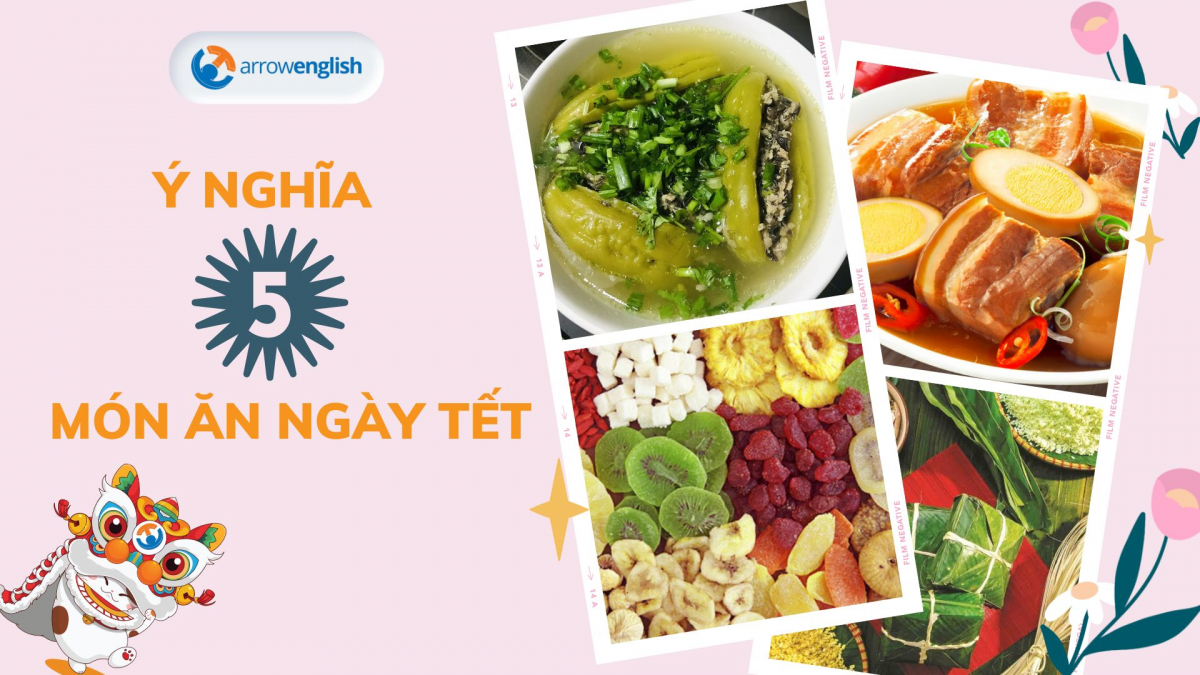Ý nghĩa các món ăn ngày Tết
Những món ăn Tết nhà nào cũng có, nhưng bạn đã biết ý nghĩa và làm cách nào diễn đạt những ý nghĩa đó bằng tiếng Anh chưa?
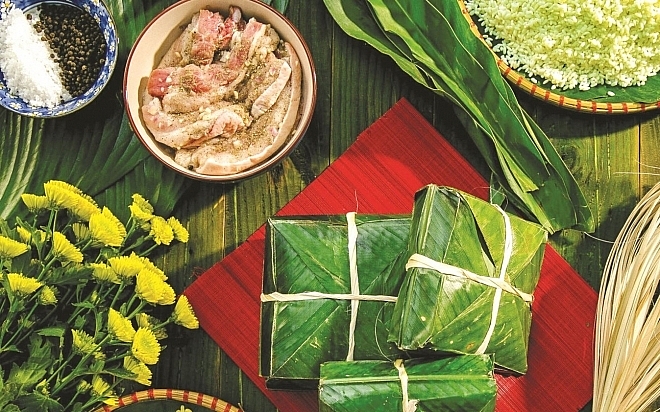
1. Chung cake – Giay cake (Bánh Chưng bánh Giầy)
This conventional food has the longest tradition compared to other kinds of food eaten during Tet, originating in the time of Hung Kings – first kings of Vietnamese civilization. The process of making this food is not only an art of combining various rustic ingredients into special shapes but also a chance to gather family members. The square shape of Chung cake resembles the earth while round Giay cake looks like the sun; therefore, a unification of these two cakes is a way ancestors express gratitude to Mother’s earth for bringing favourable weather conditions.
Món ăn truyền thống này có lịch sử lâu đời nhất so với các loại thức ăn truyền thống mùa Tết, bắt nguồn từ thời Hùng Vương – những vị vua đầu tiên của nền văn minh nước Việt. Quá trình làm ra món ăn này không chỉ là một nghệ thuật của việc kết hợp nhiều nguyên liệu dân dã và gói thành hình dạng đặc biệt mà còn là dịp để gắn kết các thành viên trong gia đình. Hình vuông của bánh Chưng tương tự như đất trong khi hình tròn của bánh Giầy nhìn như mặt trời, vì vậy sự kết hợp của 2 loại bánh này là cách tổ tiên thể hiện lòng biết ơn đến trời đất đã đem lại mưa thuận gió hòa.
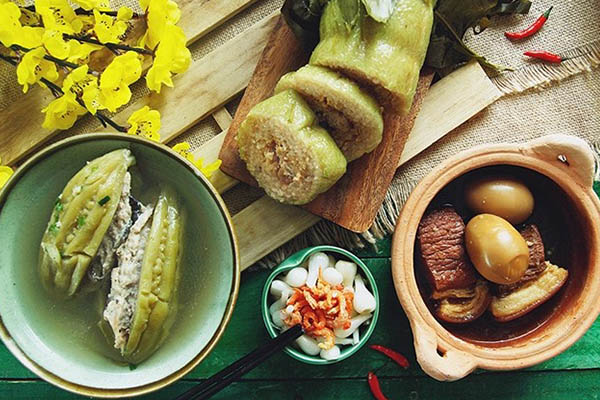
2. Bitter melon soup (Canh khổ qua)
The soup’s meaning comes from the wordplay of southern Vietnamese people ‘Eat bitter melon so that everything bitter will come by’. Many Vietnamese people also love the distinctive bittersweet taste of bitter melon, which can be distasteful at first bite but leave a sweet aftertaste. This is a simple wish for an upcoming year ‘going off without a hitch‘.
Ý nghĩa của món canh này đến từ cách chơi chữ của người miền Nam Việt Nam “Ăn khổ qua cho mọi việc ‘khổ’ qua đi”. Nhiều người Việt Nam cũng yêu thích mùi vị đặc trưng vừa ngọt vừa đắng của khổ qua: đắng khi cắn miếng đầu nhưng hậu vị lại ngọt. Đây là lời chúc đơn giản cho một năm mới ‘thuận buồm xuôi gió’.
3. Caramelized pork and eggs (Thịt kho hột vịt)
This is an all-time favorite food for many southern vietnamese households. It used to be a must-have in the old days when markets were off for a long time during Lunar new year. The dish is a combination of many ingredients, which represent unity and fullness. According to yin-yang theory, round eggs are also the symbol of yang while square pieces of pork are yin.
Đây là món ăn yêu thích mọi thời đại của những gia đình vùng Nam bộ. Đây đã từng là món ăn cần phải có ngày xưa khi chợ thường nghỉ Tết khá lâu. Món ăn này là sự kết hợp của nhiều nguyên liệu, thể hiện sự hòa hợp và đủ đầy. Theo thuyết âm dương, trứng hình tròn là biểu tượng của Dương và những miếng thịt hình vuông là Âm.
Another popular name of this dish is ‘thit kho tau’ which can be interpreted as either pork poached for fishermen on boat for a long period of time or bland poached pork.
Một tên gọi khá phổ biến khác của món ăn này là ‘thịt kho tàu’, mang ý nghĩa thịt kho cho những người đánh cá phải ở trên thuyền trong thời gian dài hoặc nghĩa khác là thịt kho vị nhạt.
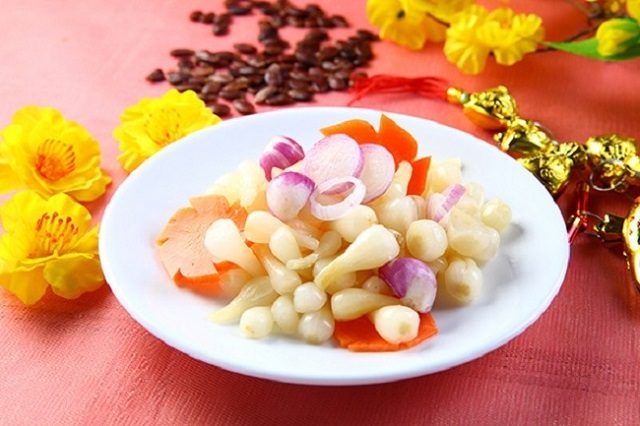
4. Pickled scallion heads (Củ kiệu ngâm)
Pickled scallion heads is a perfect match with caramelized pork for a savoury and dinstinctive dish in Lunar new year. In addition, according to the theory of five elements of nature, the salty flavor of poached pork represents Water while pickled scallion heads are sour, symbolizing Wood, creating a power couple.
Củ kiệu ngâm là sự kết hợp hoàn hảo với thịt kho cho một món ăn đậm đà đặc trưng trong Tết nguyên đán. Thêm vào đó, theo thuyết ngũ hành, vị mặn của thịt kho tượng trưng cho hành Thủy trong khi củ kiệu vị chua tượng trưng cho hành Thổ, tạo nên một ‘cặp đôi quyền lực’.
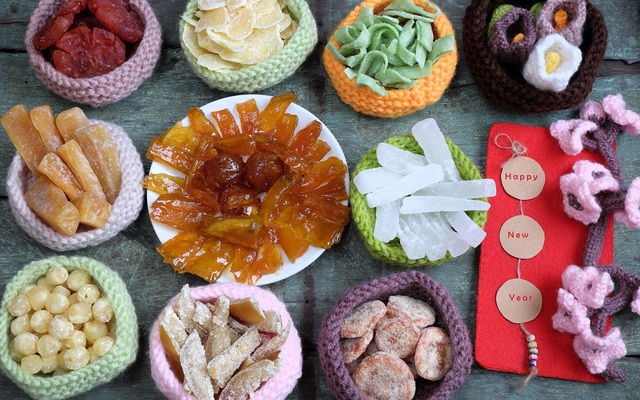
5. Dried candied fruits (Mứt)
Similar to other traditional kinds of food, the values of a tray of colorful dried candied fruits are aspirations for a beautiful year full of lusciousness, harmony and prosperity. Some common types of candied fruits commonly chosen by the Vietnamese are lotus seeds, copra, ginger, kumquat, winter melon, sweet potato. You can find a tray of dried candied fruits nearly in every household as relatives and guests often gather around and nibble some candied fruit while sipping tea.
Tương tự như những loại thức ăn truyền thống khác, giá trị của một mâm mứt tết đủ màu sắc là mong ước cho một năm tốt đẹp với nhiều sự ngọt ngào, hài hòa và thịnh vượng. Những loại mứt thường được người Việt chọn là hạt sen, cơm dừa, gừng, tắc, bí đao, khoai lang. Bạn có thể tìm thấy một khay mứt ở bất kỳ nhà nào vì những người thân và khách thường cùng quây quần, nhâm nhi một ít mứt và nhấp ngụm trà.
Chúc bạn một cái Tết vui vẻ ngọt ngào. ♥

